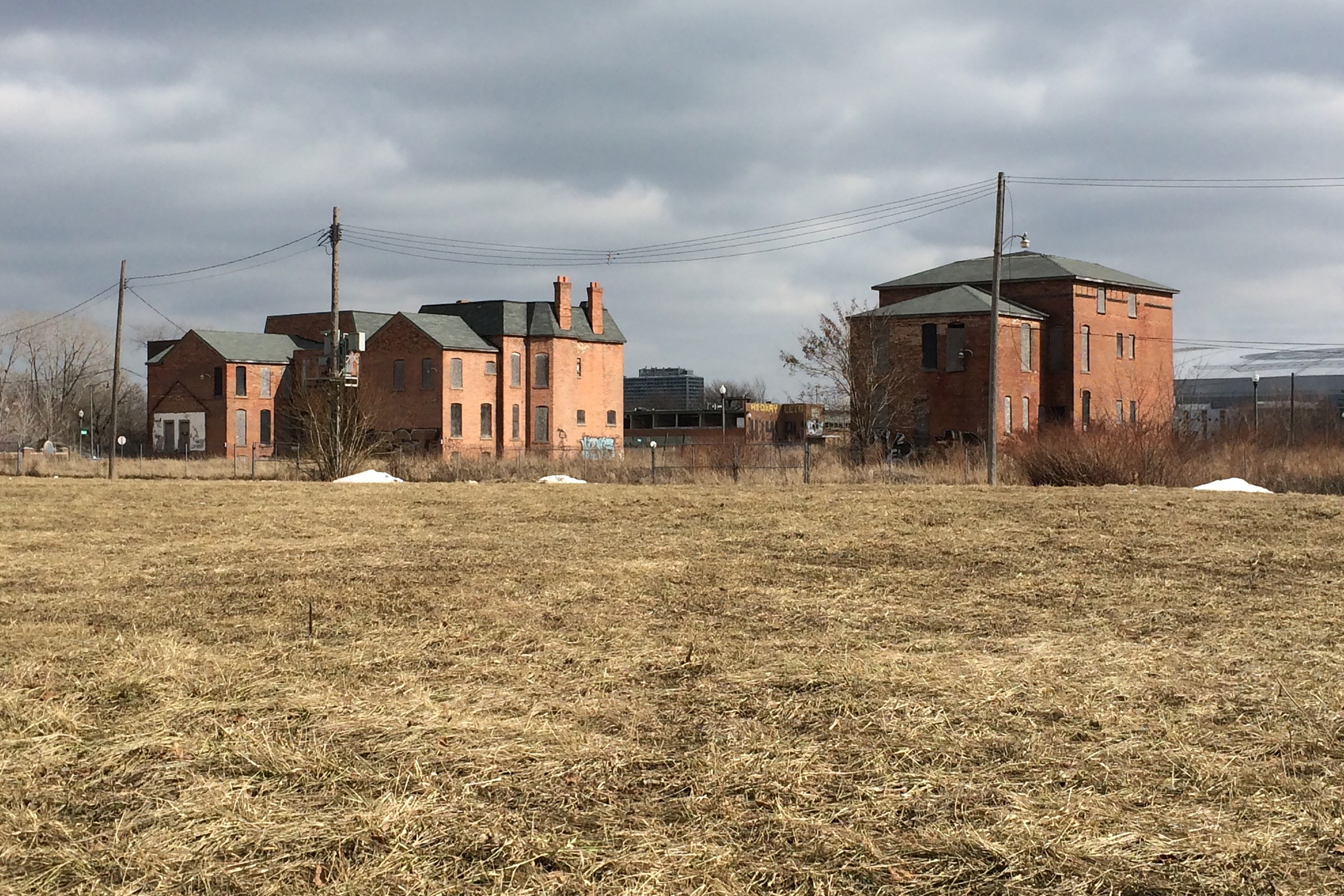![]() Mapping Architectural Significance in Areas of Detroit Doomed for Demolition
Mapping Architectural Significance in Areas of Detroit Doomed for Demolition
Originally published on Architizer, 21 July 2014Buildings form a collective narrative of a city’s history, made visible. Detroit’s chart an industrial boom that led to a golden age of architecture and culture, commanding the attention of Daniel Burnham and Albert Kahn decades before Minoru Yamasaki, Philip Johnson, and John Burgee made their mark on the cityscape. The population surge that drove this cultural metropolis was drawn in by the auto industry, which furnished the same highways along which millions of that same population would flee the city for the suburbs.
The resulting decline is mapped out in the current state of Detroit’s buildings, thousands of which have fallen into decay and disrepair. This mapping was made literal earlier this year when the Detroit Blight Removal Task Force, in collaboration with Data Driven Detroit and Loveland Technologies, surveyed all 380,000 parcels of land within the vast city limits to identify those structures infected by blight. The Task Force was established at the behest of the Obama administration after Detroit became the largest city in the nation to file for bankruptcy last year.
The survey documentation was packaged into a handy data set at Motor City Mapping, which serves as a platform for residents to contribute information about properties via "blexting." The official term is to blight and texting as ‘jeggings’ is to jeans and leggings. Residents can send images of a property along with information about the parcel's condition, including whether it is occupied, requires boarding, or needs to be demolished. The impressive extent and convenience of the data will surely have architecture students everywhere bouncing on their studio stools as they devise hypothetical design interventions for the city. The Task Force findings recommend 40,077 structures for immediate removal based on clear indicators of blight, and note another 38,429 buildings headed in the same direction if preventative action is not taken.
These tallies seem consistent with the popular image of Detroit, which suggests the city itself is abandoned, like a post-apocalyptic setting onto which Will Smith might stride at any moment. This image neglects Detroit's existing population, which totals nearly 700,000; more than Seattle, Nashville, or Boston. In addition to several residential districts, these residents have kept many of the city’s architectural treasures afloat even as funds receded and the city plunged deeper into the rising tide of decay. The Fisher Building, an Art Deco glory by Albert Kahn, and the Fox Theater, designed by Howard Crane, remain splendidly intact and in use. In order to preserve these thriving districts and neighborhoods, the Task Force emphasized the urgency of the campaign. Dan Gilbert, Task Force co-chair and chairman of Detroit-based corporation Quicken Loans, stated, “like cancer, unless you remove the entire tumor, blight grows back.”
Though striking, the analogy falls short. Cancer is a disease, a cause, while blight is a symptom of much larger, deep-seeded issues planted in the city’s social and political structures. Still, it is difficult to argue with the assault against blight. It is a type of cut-our-losses pragmatism that ranks as one of the most decisive moves city officials have made in decades. The approach signifies the shift in recent years from a focus on restoring Detroit to its former glory to an acceptance, even embrace, of other possible futures. The intent is not to keep an idealized version of the city on life support, but to facilitate reincarnation. Perhaps clearing those remains of the old industrial hub beyond saving will mean a clear path to Detroit’s next iteration, whatever that may be.
As the nation’s largest felled giant, Detroit will set the precedent for how to proceed with other industrial cities in decline. Historic preservation must be established as part of the process, so the city’s past life isn’t erased in preparation for its next one. Many of the city's residents remember the Detroit of a past era, before the glimmer faded from the gilded halls of ballrooms and theaters and neighborhoods disappeared. Buildings serve as a physical representation of these memories, however, and if culturally significant structures don’t make the transition into Detroit’s future, its past may soon be forgotten.
When the Detroit Land Bank Authority identified six target areas to launch the blight eradication efforts, Preservation Detroit and Michigan Historic Preservation Network recognized a need to join the conversation. Demolition in these areas is to be funded by the Hardest Hit Funds, which are exempt from oversight by historic preservation networks. PD and MHPN took a proactive approach, partnering with the data collection powers behind Motor City Mapping to to add a historic resource layer to the survey before demolition is fully under way. Where the Task Force data categorizes properties based on condition, the historic resource survey ranks by historic significance. The data will allow the preservationists to contribute to the conversation about what should be left standing when the demolition dust settles.
“Demolition absolutely needs to happen,” said Emilie Evans, a specialist at MHPN, “but strategically.” The resource survey categorizes buildings as Very Important, Important, and Less Important based on the property’s architectural integrity, whether it is in keeping with the character of a block, and the intactness of the block as a whole. “Very Important would not necessarily suggest that we would go to bat for a property, but provide an opportunity for us to step in and have a conversation about why the building is a demo candidate and whether it should be," explained Evans.
This historic layer covers only a small portion of the more extensive Motor City Mapping data so far, and one that is predominately residential. Evans notes that, given adequate funding, MHPN and PD would love to continue the historic resource survey to identify structures that merit pause before demolition throughout the city. The initial data collection was conducted by volunteers with backgrounds in architecture, urban planning, and historic preservation, but Evans expressed a desire to open the survey to the majority of Detroiters, who may have a more intimate understanding of the neighborhoods.
Meanwhile, structures elsewhere are subject to the earnest efforts of the Task Force. Mayor Duggan speaks of blight as a caped crusader might describe his evil nemesis, urging private property owners to join the government efforts before the villain throttles the city in its brittle grip. Earlier this month, the mayor got things underway with the Moroun family of Detroit International Bridge Company, a Detroit property mogul. Several brick warehouses on Fort Street, purchased last year by the Morouns, crumbled as press stood by. For his efforts, Mayor Duggan gave Matthew Moroun, vice chairman of the Bridge Company, a metaphorical slap on the back. “If you’ve got a vacant commercial building in this town and you don’t have the ability to reuse it, we need you to step up and knock it down,” Duggan said.
Many residents recoiled at the move, questioning why the effort would begin with structurally stable buildings slated to become a parking lot. Task Force documentation seems aimed at residential properties, many of which have fallen to the city through foreclosure and reposession due to delinquent tax payments. The city is right to demolish the vast majority of these structures, which are a threat to physical safety and provide fodder for the feast of urban decay imagery non-residents have been devouring from a distance.
Still, many notable structures fall within the heap slated for demolition, in addition to many others outside public possession. As private property, the warehouses on Fort Street did not fall under the city’s authority, and demolition was financed by the owners. The Morouns also own Michigan Central Depot, a poster child of urban decay that towers over the surrounding vacant lots like a skeleton of Detroit’s once-extensive public transportation system. As the warehouses on Fort Street fell, Matthew Moroun cited the millions he intended to invest in restoring the Depot. The Packard Plant, another icon of decay and graveyard of the old grandeur of the auto industry, was purchased earlier this year. Could this hint at a larger plan to breathe life into the most notorious of the city’s remains?
Both the Depot and the Packard Plant are highly visible, privately-owned properties that fall outside the City’s jurisdiction. Other architectural gems that contributed significantly to Detroit’s cultural history might be on the chopping block, including the Goeschel Building and the Grande Ballroom. Though ideas have been tossed around for planting urban orchards and meadows, the Blight Removal Task Force offers no plan for how to progress once the 40,000 buildings suggested for demoliton are razed.
Vacant structures will become vacant lots, raising the fear that many significant buildings might go the way of the Hudson's building. This prominent Detroit presence was imploded in 1998 and remains a vacant stretch of asphalt, its own form of blight on a main thoroughfaire at the heart of the city. The site abuts the Quicken Loans headquarters, from which Gilbert has launched his own effort to revive Detroit. He has invested heavily in the city, and recently partnered with SHoP and Detroit-based Hamilton Anderson Associates to develop the Hudson’s site from the ground up.
Though the mending of this hole in the urban fabric is sure to be a positive contribution, the site might otherwise have benefited from the adaptive reuse efforts SHoP is pouring into the Domino Sugar Refinery. Located on Brooklyn’s formerly-industrial waterfront, the project is a nod to the history of the area, though the historic portion may be slightly overshadowed by the towering megacondos.
The renowned Westin Book Cadillac Hotel was recently renovated after decades of neglect, indicating the potential for similar results at the Depot and the Packard Plant. If these buildings without benefactors could hold out like little orphan Annie for her Daddy Warbucks, there are certainly others deserving of future homes — right where they’re standing. Nostalgia won’t bring back the booming metropolis of yore, but wholesale demolition of all blighted structures leaves little room for a future Detroit, whatever that may be, that recognizes its past.


 Mapping Architectural Significance in Areas of Detroit Doomed for Demolition
Mapping Architectural Significance in Areas of Detroit Doomed for Demolition